Arctic
Adventure, Nature, and Wildlife Travel
A Voyage by Icebreaker Ship Along
the Edge of the World
Article and photos
by Lies Ouwerkerk
Senior
Contributing Editor
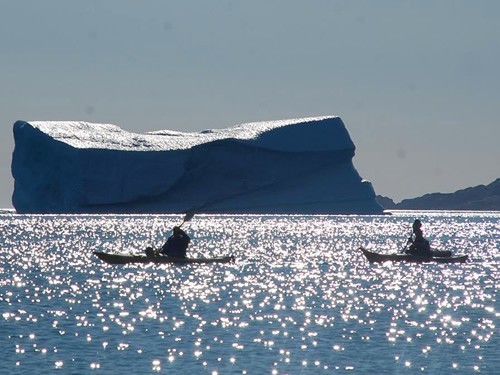
|
|
In paddling boats near a spectacular
iceberg.
|
Traveling on an icebreaker had been
on my wish list for quite a long time. Polar expeditions
do not come cheap, however, as icebreakers are extremely
expensive to run due to high fuel costs and crew/staff — passenger ratio. But when an extra work contract fell unexpectedly
into my lap this year, I jumped at the sudden opportunity
to make my dream come true. The Akademik Ioffe,
a working Russian research vessel and passenger ship was
just about to make its once-a-year journey from Iceland
to Greenland and Arctic Canada, and a bunk bed was still
available in one of its shared cabins. Soon I was off to
Reykjavik, from where the ship would set sail.
The Expedition Leader's Warnings
“If we want our next generation to make
the same trip, we have to show our utmost consideration
for this fragile environment,” says expedition leader Graham
Charles to the approximately 70 passengers from all corners
of the world, who have congregated in the dining room for
a welcome drink and a mandatory lifeboat briefing. “Besides
the basic principles of not leaving anything behind nor
taking anything with you while on shore, we have to adhere
strictly to the rules of safety and keep the minimally required
distance from the wildlife we will encounter. In the active
polar bear zones, that also means: staying in the immediate
vicinity of your armed guide and wearing your yellow parka
at all times. Yellow is polar bear’s least favorite color,
so if you stick together as a group, you will likely scare
them off.”
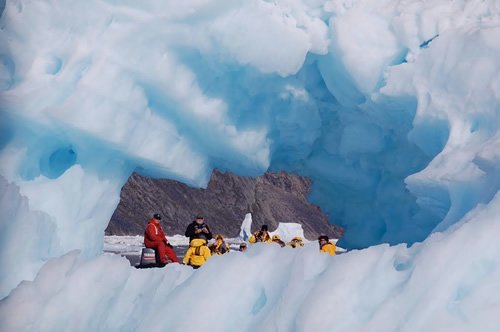
|
|
View of a "Zodiac" boat
gliding through the sea ice, seen through an opening
in an iceberg.
|
If that warning is not enough to send
a wave of apprehension through the newcomers on board about
potential encounters with the “Kings of the Arctic” — often
trapped in coastal areas in their leanest time of the year,
and hungrily awaiting fall’s return of sea ice, their crucial
hunting ground for catching ringed seals — Graham’s
explanation of the sailor’s grip, to be applied while stepping
from a wobbly gangway into rocking Zodiac boats on the choppy
and freezing mid-sea waters, finishes the job of sending
a shock wave through the group. Many still feel a bit fragile,
trying to combat jetlag and ward off motion sickness with
magic wristbands or patches behind their ears, in anticipation
of crossing rough seas in the Danish Strait.
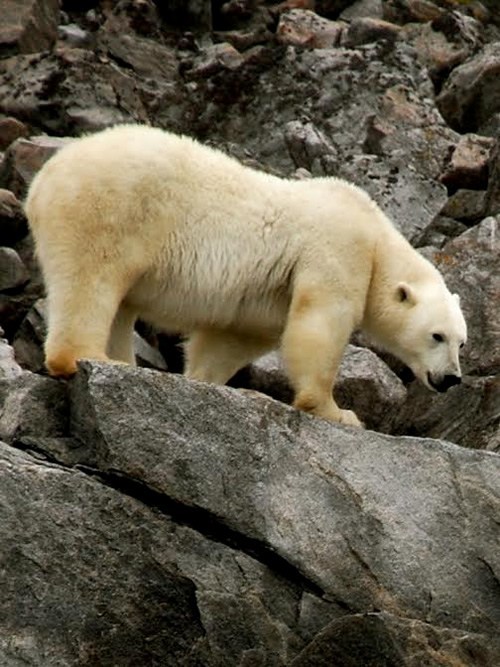
|
|
Polar bears are known to get
hungry in summer when the sea ice is melting and
they are forced to come to shore to roam for food.
|
The Expedition Begins
“And now, up to the whales!” our leader
quips while raising a glass to the success of our expedition.
“Anybody here who wants to see a humpback whale or a school
of orcas from the bridge”? This time, all hands go up.
In the days to follow, when all of us
have acquired sea legs, a yellow parka, and enough courage
to brave the kayaks and Zodiacs, our expedition staff takes
us out on daily excursions into hidden fjords and along
enormous sapphire- and emerald-colored icebergs, endlessly
different in shape, and slowly making their way south through
the ocean, after calving off one of the many Greenland glaciers.
We go on hikes in the wilderness around small bays and inlets
and visit remote and abandoned fishing settlements. We set
foot in world’s smallest capital Nuuk, where we view 15th-century mummies in Greenland’s National Museum.
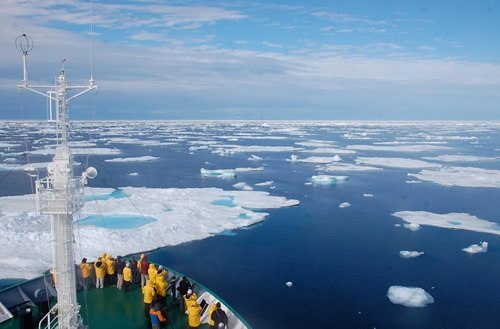
|
|
Looking out at icebergs small
and large, floating in the ocean after breaking off
of glaciers.
|
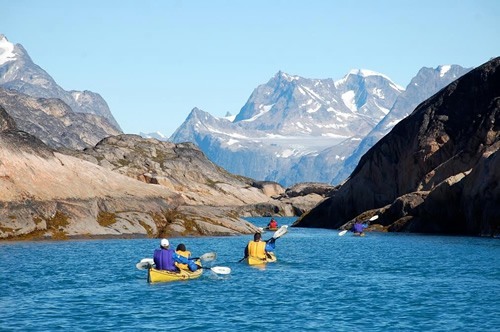
|
|
Paddling into paths created by
fjords.
|
In Ilulissat, situated on Greenland’s
west coast, about 250 km north of the Arctic Circle, in
the dramatic surroundings of one of the world’s most spectacular
ice fjords — Unesco World Heritage Site since 2004 — we
visit the house of Greenland’s greatest explorer, Knut Rasmussen.
In other Inuit towns such as Tasiilaq, Nanortalik, and Sisimiut,
with their colorful wooden houses built in rocky harbors,
quiet and friendly locals put on shows with traditional
songs, music or dance.
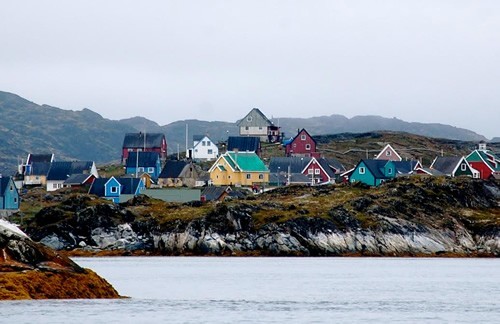
|
|
View of a colorful town.
|
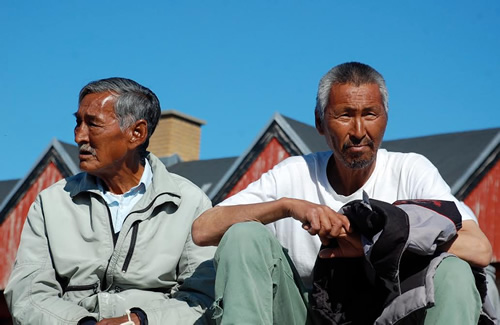
|
|
Local men relaxing in town.
|

|
|
Friendly local women.
|
In addition, we have our own entertainment
on board, when some of the most courageous passengers dare
to take a plunge into the ice-cold ocean.
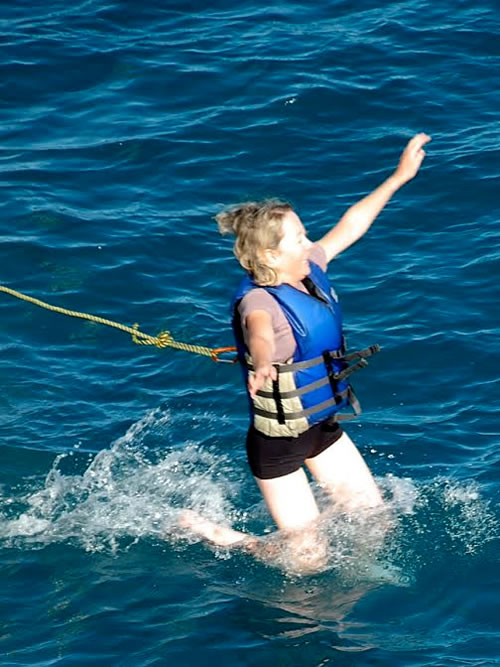
|
|
A brave woman dares to
take the plunge.
|
Besides skillfully maneuvering Zodiacs
on choppy waters, our expedition guides are also accomplished
lecturers, passionately presenting talks on their individual
areas of specialization:
-
An Australian geologist explains
the changes in Greenland’s melting ice sheet which now
covers about 90% of the country’s surface, its effects
on glaciers, rivers, and icebergs, and its subsequent
impact on the whole world.
-
A British ornithologist warms us
up for the many Arctic birds still to spot during the
rest of our journey such as the Long-tailed Skua, the
Black Guillemot, and the Sooty Shearwater.
-
A Canadian historian relates the
harrowing stories of explorers like Sir John Franklin
and Roald Amundsen, who for years braved the icy waters
and the darkness of winter in order to discover an oceanic
shortcut from the Atlantic to the Pacific across the
top of North America.
-
A Polish zoologist introduces us
to the world of polar bears, whales, and narwhals.
-
Our own expedition leader from New
Zealand recounts the nail-biting story of his 35-day
traverse of Greenland’s icecap.
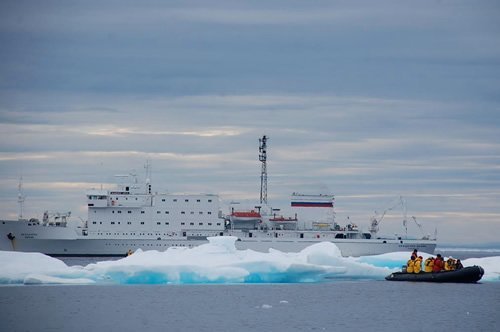
|
|
During the voyage on our ship,
passengers often make their way to shore on a small "Zodiac" boat.
|
Life on the Ship
Although the majority of cabins and
bathrooms are small, life on the ship is much more luxurious
than I ever had imagined. The kitchen staff treats us as
if we are on a true cruise ship: buffet-style breakfasts
and 3-course lunches and dinners, with extensive wine lists
to match. Their menus are imaginative and pleasing to the
palate, from Teriiyaki Yellow Fin Tuna, to New Zealand Lamb
Shanks and Smothered Chicken Saltimbocca.
Yet, I sometimes wish for less focus
on food and socializing, and just a simple sandwich on the
deck instead, where I can surrender to the silence, the
huge open expanses of nothingness, the warm sunrays on a
cloudless day, and the endless skies that turn into a magical
spectacle as the sun sinks into the horizon for a couple
of hours around midnight.
After our expeditions, there is a gym,
a sauna, a well-stocked library, and a lounge with DVD’s
to return to, or a bar with enticing cocktails named after
our activities or sightings of that day such as the “Spiked
Viking”, the “Pink Puffin”, the “Throat Stinger”, and the
“Fin Fizz.”
Polar Bear Spotting
“Who wants to see a polar bear?” inquires
Graham over the intercom, when the ship is heading toward
Canada’s Baffin Island through the vast pack ice. That sends
everybody, cameras with huge lenses in tow, immediately
to the decks, where giant binoculars are set up to scan
the many floes for polar bears, known to hunt here for seals.
As soon as a bear is spotted, the ship digs deeper into the
pack ice. Cameras are already clicking left and right although
the bear is still hardly visible to the eye. But soon, at
a distance of not more than 40 meters from the ship, we
can view our first polar bear of the trip. The animal seems
hardly disturbed by our arrival, still in a stupor after consuming
a seal, judging by the carcass stripped of its blubber at
the side.
Suddenly seized by bear fever, we venture
through the pack ice in Zodiacs later that day. With the
help of our "Eye in the Sky" on board of the Akademik
Ioffe, the Zodiac drivers are guided through their
transceivers into the right direction. Our boats drift in
pairs and on one engine through the breathtaking icescape,
and when closer to the bear, the guides use only paddles.
Silent and in awe, we are face to face with the largest
predator of the high Arctic, pacing over ice floes while
sizing us up, then slowly sliding into the ocean and swimming
away.
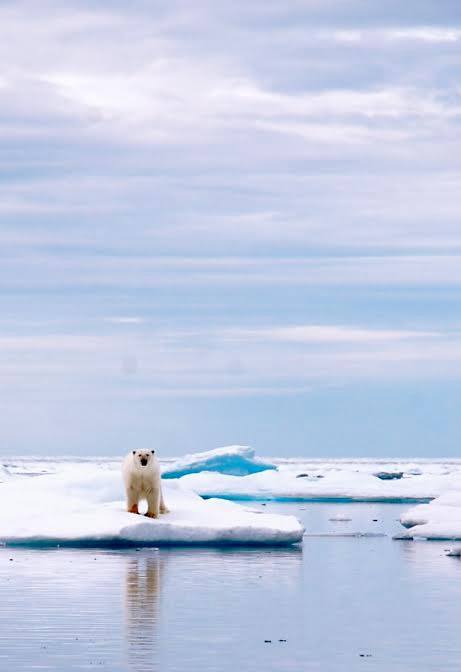
|
|
Staring down a polar bear who
remains at a safe distance.
|
“We can never plan and promise to view
these Arctic icons for sure,” says a relieved Graham at
the end of this memorable day, “but thanks to your flawless
team effort, we were able to watch some true model bears
today!” A thunderous applause follows.
After 3,055 nautical miles on the water
using 180 tons of fuel, and a final wet Zodiac landing near
the shores of Iqaluit, return to normal life comes as a
total shock.
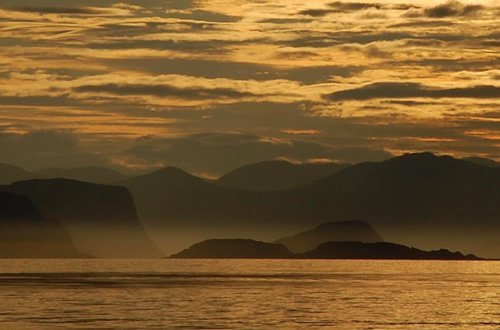
|
|
An other-worldly arctic sunset.
|
Life After the Expedition
For at least a week, my gait remains
unsteady, while I imagine the floor bobbing under my feet.
The humming of my fridge sounds like the steady engine of
the Akademik Ioffe, and in the zooming sound of
traffic passing by my window I hear the waves sloshing rhythmically
against the sides of the ship. I dream of magnificent icescapes
against perfectly blue skies, and in it huge Atlantic puffins
playing with cuddly little bear cubs, white as snow. And
when my alarm clock goes off, the reporter seems to murmur
the well-known lines of our "Eye in the Sky":
“Good morning, ladies and gentlemen, this is a gentle wake-up
call from the bridge, where we have spotted a giant albatross
and some killer whales this morning. For the earlybirds
among you, this is an invitation to come up and watch them
for yourselves, and for those who might still like to dream
on a bit, see you in half an hour at the breakfast table...”
|
For More Info
Quark
Expeditions organizes a large variety of
expeditions in the Arctic (and Antarctica),
with prices at this writing starting at
$9,500 for an 10-14-day voyages.
Check the website for the latest expeditions
and prices.
Prices include all meals on
board, 2 nights hotel in ports of departure and
arrival, a parka to keep, a DVD of the trip in
the end of the voyage, use of binoculars and rubber
boots, evacuation insurance, and services of a
doctor on board.
For individual trips and hikes
in Greenland and Canada only, check out Visit Greenland, Greenland Mountain Guides,
and Auyuittuq
National Park of Canada.
|
Lies
Ouwerkerk is originally from Amsterdam,
The Netherlands, and currently lives in Montreal,
Canada. Previously a columnist for The Sherbrooke
Record, she is presently a freelance writer and
photographer for various travel magazines.
|
